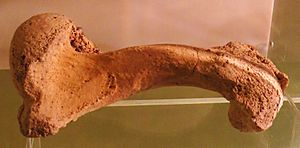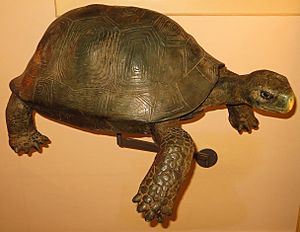Tenerife giant tortoise facts for kids
Quick facts for kids Tenerife giant tortoiseTemporal range: Miocene–Pleistocene
|
|
|---|---|
 |
|
| Bone rest of Geochelone burchardi in Museo de la Naturaleza y el Hombre in Santa Cruz de Tenerife. | |
| Scientific classification | |
| Genus: |
Centrochelys
|
| Species: |
burchardi
|
| Synonyms | |
|
Testudo burchardi Ahl, 1926 |
|
The Tenerife giant tortoise (Centrochelys burchardi) was a huge turtle that lived a long, long time ago. It was a type of cryptodire turtle, which means it could pull its head straight back into its shell. This amazing creature belonged to the Testudinidae family, which includes all land tortoises. It lived only on the island of Tenerife in the Canary Islands. Sadly, it is now extinct.
Meet the Giant Tortoise
The Tenerife giant tortoise was very big. It was similar in size to the giant tortoises you can find today. These living giant tortoises live on islands like the Galapagos Islands in the Pacific Ocean. You can also find them on Aldabra and the Seychelles islands in the Indian Ocean.
The oldest remains of Centrochelys burchardi found on Tenerife are from the Miocene epoch. This was a very long time ago! Scientists believe this tortoise lived on the island until the Upper Pleistocene epoch. This was also long before humans arrived during the Holocene epoch.
The tortoises died out because of volcanic activity on the island. Most of the fossils found are bones and parts of their shells. Scientists also found a nest of fossilized eggs. These eggs were found in volcanic soil in the south of Tenerife. This area is now called Adeje.
A scientist named Ernst Ahl first described this giant tortoise in 1926. It was the first time a giant tortoise from the Canary Islands was officially described.
Other Giant Tortoises
Another extinct giant tortoise is C. vulcanica. This one lived on the island of Gran Canaria. The shell of C. burchardi was quite large. It measured about 65 to 94 centimeters long. The shell of C. vulcanica was a bit smaller, around 61 centimeters long.
Scientists think that the ancestors of these tortoises came from Africa. They might have reached the eastern Canary Islands first. Then, they slowly moved westward across the islands. As they moved, their size grew, and they changed to fit their new island homes.
Fossilized tortoise eggs have also been found on the islands of Lanzarote and Fuerteventura. However, these eggs have not been fully studied or named yet. Some people think the eggs from Fuerteventura might be from C. burchardi. But this idea is not certain, and some scientists disagree.
See also
 In Spanish: Centrochelys burchardi para niños
In Spanish: Centrochelys burchardi para niños
- List of extinct animals
- List of African animals extinct in the Holocene
- List of extinct animals of Europe
- Island gigantism


